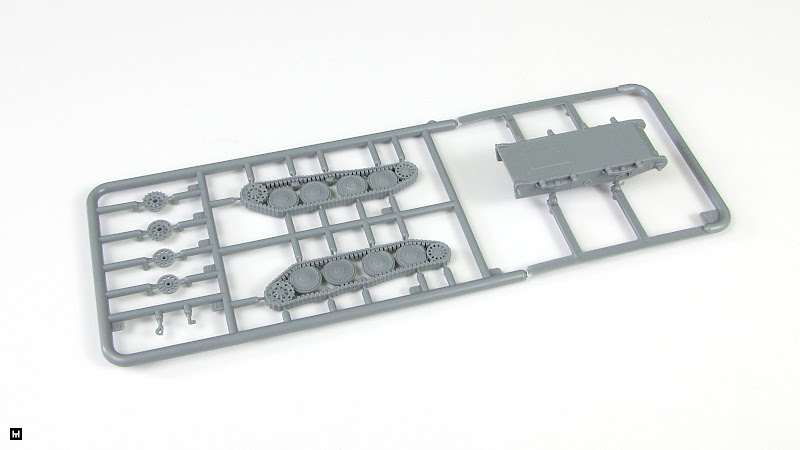Czechoslovakian Panzer

Eighty-first issue of the “September 1939” wargaming series comes with the miniature of the PzKpfw 38(t) Ausf. A tank in 1:72 scale. The kit stands out a bit compared to the previously issued First To Fight ones due to… but more on that below.
Other ones
The Czechoslovakian LT vz. 38 tank, better known under the stage name PzKpfw 38(t) (or the nickname Panzer 38), may not be the most popular subject, obligatory in the catalogue of every respectable scale models manufacturer. Nevertheless, one cannot complain about the lack of kits featuring this type. The quality is a different matter – neither the models produced by the Czech Attack company nor by the Ukrainian UM (aka UniModels) are very impressive.
The new, even simplified model of the “thirty-eight” can therefore be an interesting proposition also for “non-wargaming” modellers, all the more so considering the availability of the aforementioned competition - currently basically none.
General information
The box with catalogue number PL1939-081 and characteristic for the series graphic layout is the standard side-opening one.
Contains five injection moulded sprues with grey parts, decals sheet and a little PE fret (!).
Of course we also get the A4 booklet, excellent as always – let's leave it at that this time.
Sprues
Before looking closer at the kit content, let's just quickly scan the plastic frames. “A” is the largest one (and therefore had to be cut in order to fit in the standard box) – contains, among other things, tracks and the running gear components.
Rest of the hull can be found on the “R” sprue.
„B” contains mainly turret elements.
While “J” and “G” include different details and walls absent on the previously mentioned mouldings, both for the hull and the turret.
All in all, quite a lot of elements for a “wargaming” kit of such a small vehicle. Let’s take a closer look.
Inspection
Let's start with the tracks, which typically are the weakest point of the vehicles issued in the “September 1939” series. This time the designer didn't try anything new, like in the case of the Panzerkampfwagen III Ausf. D (see review) – we get one-piece, simplified modules that are typical for this manufacturer.
The only exceptions are the tension and drive wheels, the inner disks of which are glued separately, so that the edges of the resulting assembly won't be so hideously thick this time.
So we've got not the worst looking tracks with horrible teeth, which in this case are more like tracks humps.
Suspension details are also simplified, reproduced directly on the otherwise quite nice lower hull.
The latter is completed by separately moulded walls. Rear.
And the front one, which takes up the entire sprue, as you can clearly see below.
The entirety will be covered by the upper hull moulded together with the mudguards.
On which some equipment details were directly reproduced.
But not all of them – a jack for example comes as a separate part.
The crew compartment requires the addition of a front armoured wall.
As well as the sides.
And the top.
In the front armour we can install a machine gun mount (the gun itself, together with its turret-mounted counterpart, can be seen in one of the earlier photos, right next to the jack) or a blank cover – your choice.
Main turret part…
…should be fixed to a base, which provides the ability to rotate the assembly in the finished miniature.
Then supplemented with front armour.
Main gun (in my case with slightly off-centre muzzle, due to moulding imperfection).
And the commander's cupola.
Other individually attached details include the exhaust muffler.
Spade and a pickaxe, mounted on the rear wall of the hull.
Half-frame antenna.
Towing hook.
Reflector and the rod antenna base.
If it weren't for the chassis, you might think we were dealing with a completely “normal” model.
PE details
This brings us to the distinctive feature of this issue. Although I do not follow the “September 1939” series very closely, I have the strong impression that the photo-etched elements appeared in it for the first time.
Not a lot of them, and frankly it is a rather bizarre choice to add a PE details to a set with a simplified, modular chassis, but hey – I'm not complaining.
Decals
The included decal sheet is also a bit different than usual. Printed nicely, as always, but this time it contains considerably more markings – including some that look a bit out of theme.
Though you won't find anywhere in the issue any information about the appearance of the vehicles other than the one with number 321, the inclusion of alternative markings makes me personally really happy.
Manual
As usual in this series, something like a manual can be found on the back of the box. The same images in a slightly larger format can also be found in the included brochure.
However, as I mentioned before – the information regarding additional markings included on the decal sheet is nowhere to be found. If you want to make, for example, a more colourful Slovak machine, you will have to do some research on your own (a small hint – the turret number 314 corresponds with the registration ending in 3).
Summary
So, how is the new issue of “September 1939”? Pretty inconsistent in my opinion. On the one hand – simplified tracks, on the other – a photo-etched details. Clearly a limited theme, but the decals go a bit beyond it. But at least it is interesting.

































